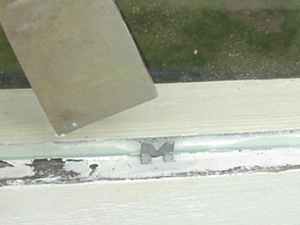Re-Glazing a Window with broken Glass Pane |
|
Playing ball inside the house and need to fix a window? Read on, and you'll be able to fix windows like there is no tomorrow. |
 |
|
Items needed:
Putty knife
Glass Glazing compound Glazer's points Chisel or Scraper Primer Paint (depends on conditions) Gloves Safety glasses |
Safety Suggestions and Tips
Keep glass wrapped in paper until use
Warm up glazing by rolling between hands Push glazing point straight into mutton, not against glass |
Level of difficulty
 Time Required: 1 hour
|
|
|
|
Steps |
|
|
|
|
Step 1: There are two different kinds of window glazing. It is available either in the can or in tube. While I sometime prefer the type in the tube, makers of canned material, such as DAP claim better durability. |
|
Step 2: First a note about safety: GLASS IS SHARP. I'd wear leather gloves and safety glasses when taking the glass out. Remove as much glass as possible from the frame. Whatever glass remains will come out when you remove the glazing compound. |
|
Step 3: With as much glass as possible removed, begin removing the glazing compound. The glazing compound is the (usually) white stuff that holds the window panes in. You can start with a putty knife, but if the glazing compound has dried hard, you may need to use something else. |
|
Step 4: Older glazing compound is oil-based and a pencil-point torch is sometimes used to soften the compound. I favor a triangular scraper. Place the triangular scraper in the groove left by the glass and twist it to break off the glazing compound. Another option is a chisel. One note: don't get too forecful with the tools, you can damage the muntins (the muntin is the grille or divider in the window). Scrape off all of the glazing compound and clean up the muntins. |
|
Step 5: Next, remove the old glazer's points from the wood |
|
|
Step 6: If the muntins are made of wood, make sure that the wood underneath the old glazing compound is primed with an oil-based exterior primer. Measure the interior dimensions of the muntins and go get an appropriately sized piece of glass. It is OK to allow 1/16" to 1/8" less than the smallest dimension. |
|
|
Step 7: Put a thin ribbon of compound around the window frame for the glass to rest in. Place the piece of glass in the opening and secure the glass in the opening with the glazer's points. The points are also available ad small flat diamonds and triangles, but this type is easiest to work with |
|
|
Step 8: Put the points against the glass with the "cleats" facing towards you. Put the scraper against the cleats and force the point into the wood. Use at least two points per side. |
|
|
Step 9: Using the small putty knife, lay in an excessive amount of glazing compound. |
|
|
Step 10: Spread the compound out with a putty knife by holding one edge against the glass and the edge on the muntin. Note that the amount of compound put into the joint is determined by how far away you put the edge of the knife along the glass. |
|
|
Step 11: Using a wide (6" or wider) knife, spread the compound that has oozed from under the patch around the patch and smooth with your finger. Make sure you work as much compound as possible from under the paper. The face of the patch should be under a light haze of compound. Let dry and lightly sand. |
|
|
Step 12: Draw the compound along the joint. When you come to a corner, simply draw the knife out of the joint towards you. |
|
|
Step 13: Allow the compound to dry and then paint the compound, check the container for the drying time and type of paint you should use. |
|
|
Step 14: Before you close that can, place a small piece of kitchen wrap to help seal out air from drying the compound for your next use. Some suggest adding a layer of liquid (thinner/oil), but I find that this makes the compound weaken over time. |
|
|